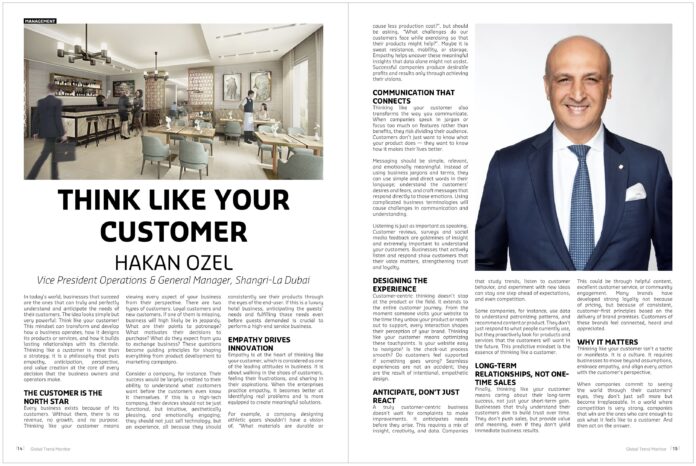By Hakan Ozel, Vice President Operations & General Manager, Shangri-La Dubai
In today’s world, businesses that succeed are the ones that can truly and perfectly understand and anticipate the needs of their customers. The idea looks simple but very powerful: Think like your customer! This mindset can transform and develop how a business operates, how it designs its products or services, and how it builds lasting relationships with its clientele. Thinking like a customer is more than a strategy; it is a philosophy that puts empathy, anticipation, perspective, and value creation at the core of every decision that the business owners and operators make.
The Customer is the North Star
Every business exists because of its customers. Without them, there is no revenue, no growth, and no purpose. Thinking like your customer means viewing every aspect of your business from their perspective. There are two types of customers: Loyal customers and new customers. If one of them is missing, business will high likely be in jeopardy. What are their points to patronage? What motivates their decisions to purchase? What do they expect from you to exchange business? These questions become guiding principles for shaping everything from product development to marketing campaigns.
Consider a company, for instance. Their success would be largely credited to their ability to understand what customers want before the customers even know it themselves. If this is a high-tech company, their devices should not be just functional, but intuitive, aesthetically pleasing, and emotionally engaging; they should not just sell technology, but an experience, all because they should consistently see their products through the eyes of the end-user. If this is a luxury hotel business, anticipating the guests’ needs and fulfilling those needs even before guests demanded is crucial to perform a high-end service business.
Empathy Drives Innovation
Empathy is at the heart of thinking like your customer, which is considered as one of the leading attitudes in business. It is about walking in the shoes of customers, feeling their frustrations, and sharing in their aspirations. When the enterprises practice empathy, it becomes better at identifying real problems and is more equipped to create meaningful solutions.
For example, a company designing athletic gears shouldn’t have a vision of, “What materials are durable or cause less production cost?”, but should be asking, “What challenges do our customers face while exercising so that their products might help?”. Maybe it is sweat resistance, mobility, or storage. Empathy helps uncover these meaningful insights that data alone might not assist. Successful companies produce desirable profits and results only through achieving their visions.
Communication That Connects
Thinking like your customer also transforms the way you communicate. When companies speak in jargon or focus too much on features rather than benefits, they risk dividing their audience. Customers don’t just want to know what your product does — they want to know how it makes their lives better.
Messaging should be simple, relevant, and emotionally meaningful. Instead of using business jargons and terms, they can use simple and direct words in their language; understand the customers’ desires and fears, and craft messages that respond directly to those emotions. Using complicated business terminologies will cause challenges in communication and understanding.
Listening is just as important as speaking. Customer reviews, surveys and social media feedback are goldmines of insight and extremely important to understand your customers. Businesses that actively listen and respond show customers that their voice matters, strengthening trust and loyalty.
Designing the Experience
Customer-centric thinking doesn’t stop at the product or the field. It extends to the entire customer journey. From the moment someone visits your website to the time they unbox your product or reach out to support, every interaction shapes their perception of your brand. Thinking like your customer means optimizing these touchpoints. Is your website easy to navigate? Is the check-out process smooth? Do customers feel supported if something goes wrong? Seamless experiences are not an accident; they are the result of intentional, empathetic design.
Anticipate, Don’t Just React
A truly customer-centric business doesn’t wait for complaints to make improvements. It anticipates needs before they arise. This requires a mix of insight, creativity, and data. Companies that study trends, listen to customer behavior, and experiment with new ideas can stay one step ahead of expectations, and even competition.
Some companies, for instance, use data to understand patronizing patterns, and recommend content or product. They don’t just respond to what people currently use, but they proactively look for products and services that the customers will want in the future. This predictive mindset is the essence of thinking like a customer.
Long-Term Relationships, Not One-Time Sales
Finally, thinking like your customer means caring about their long-term success, not just your short-term gain. Businesses that truly understand their customers aim to build trust over time. They don’t push sales, but provide value and meaning, even if they don’t yield immediate business results.
This could be through helpful content, excellent customer service, or community engagement. Many brands have developed strong loyalty not because of pricing, but because of consistent, customer-first principles based on the delivery of brand promises. Customers of these brands feel connected, heard and appreciated.
Why it Matters
Thinking like your customer isn’t a tactic or manifesto. It is a culture. It requires businesses to move beyond assumptions, embrace empathy, and align every action with the customer’s perspective. When companies commit to seeing the world through their customers’ eyes, they don’t just sell more but become irreplaceable. In a world where competition is very strong, companies that win are the ones who care enough to ask what it feels like to a customer. And then act on the answer.
#GTM #GlobalTrendMonitor #ThinkLikeACustomer #CustomerFirst #EmpathyInBusiness #CustomerExperience #CXMatters #CustomerCentricity #BusinessWithHeart #CustomerDriven #BuildWithCustomers #DesignForTheUser
